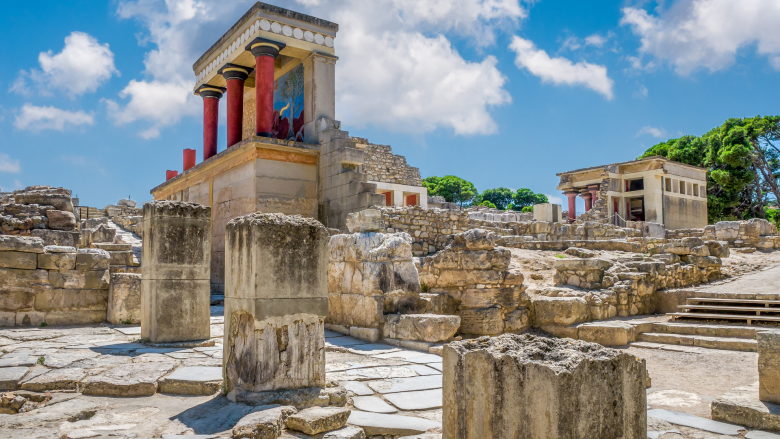Discovering the Minoan Enigma: The Allure of the Snake Goddess

The ancient Minoans of Crete have left behind a legacy that has captivated historians, archaeologists, and travelers alike.
Among the most intriguing artifacts from this Bronze Age civilization are the Minoan Snake Goddess figurines, figures shrouded in mystique and wrapped in the serpentine coils of history and mythology. As we unravel the tale of these enigmatic figures, we invite you to journey with us through the labyrinth of Crete’s past, into the very essence of a civilization where women, snakes, and gods intertwined in a dance as complex as the Minoan palaces themselves.
Mysteries in Clay: Discovering the Snake Goddess
Firstly, the discovery of the Minoan Snake Goddess figurines at the turn of the 20th century was a breakthrough that offered an unprecedented glimpse into Minoan spirituality and artistry. Unearthed within the temple repositories of the palace at Knossos by the legendary archaeologist Sir Arthur Evans, these figurines have ignited a spark of heated debate and fascination. Standing with upraised arms and draped in intricately designed robes, the figurines grasp serpents in their hands—a symbol whose myriad interpretations weave through various strands of academic thought.

Decoding the Divine: Who Was the Minoan Snake Goddess?
Secondly, scholars and enthusiasts alike have pondered the significance of these mysterious figures. Was the Minoan Snake Goddess an all-powerful mother goddess, or was she a priestess performing ritual acts? Nonetheless, the figurines, discovered in virtually every Minoan palace site, highlight her ubiquity and importance in Minoan society. She may have been a household deity, watching over domestic spheres, her snakes symbolizing the protection of the home.
The debate extends to the attire of the goddess. The bare-breasted figurines are a testament to the Minoan culture’s celebration of the natural form and perhaps an indication of the society’s matrilineal leanings. However, with their regal posture and command over the serpents, these figures could embody the authority and respect accorded to women in Minoan society—an aspect that continues to intrigue feminist historians and cultural anthropologists today.
Artistic Mastery: The Minoan Aesthetic
Thirdly, the finesse of the Minoan artists is evident in the lifelike rendering of the Snake Goddess figurines. Their almond-shaped eyes, detailed garments, and the naturalistic portrayal of the snakes all reflect an art form that took inspiration from nature and human experience. The garment of the goddess, with its open bodice, is particularly striking, revealing the Minoans’ comfort with the human body and their celebration of fertility and femininity.

Cultural Crossroads: The Influence of Minoan Crete
Fourthly, Crete’s position in the Mediterranean facilitated the flow of ideas and styles, with the Minoan Snake Goddess embodying a synergy of these cultural exchanges. Their civilization, one of the earliest in Europe, thus became a cornerstone of cultural development, with its art influencing the mainland Greek culture and beyond. The Minoan influence permeated through trade, as Crete was a significant maritime power, to the point where echoes of Minoan religious practices can be discerned in the later Greek pantheon and rituals.
Spirituality Entwined: The Serpent’s Symbolism
Serpents, throughout ancient cultures, have been associated with a variety of meanings. From malevolence to wisdom, and in the case of the Minoan Snake Goddess, possibly immortality and renewal. The serpent’s ability to shed its skin made it a symbol of rebirth and transformation. A fitting attribute for a goddess who may represent the cycles of life and nature, don’t you think?
The Goddess Today: A Modern Pilgrimage
Modern fascination with the Minoan Snake Goddess transcends academic study; it touches those seeking a link to the spiritual past. Her image has been adopted by various movements. Such as a symbol of matriarchy, nature worship, and the divine feminine, resonating with contemporary quests for meaning and identity.

Embark on Your Own Odyssey
In light of the Snake Goddess’s enduring appeal, a journey to Crete is not just a vacation. It’s a pilgrimage to the heart of ancient spirituality and sophistication. Moreover, with Elissos Travelling Philosophy, your trip is more than sightseeing; it’s an intimate encounter with the past. Furthermore, we offer personalized tours that let you explore the mysteries of the Minoan world. Our team of expert travel designers will guide you.
Additionally, our tours are not mere walks through historical sites; they are immersive experiences. Imagine yourself participating in workshops that teach the ancient art of Minoan pottery. Using the same techniques that crafted the very idols of the Snake Goddess. Or engaging in a vibrant discussion on Minoan society with local experts who bring the past to life.
Finally, visit Elissos Travelling Philosophy’s Tour Customization to begin crafting your adventure into the world of the Minoans. Connect with us at operation@elissos.com for a travel experience designed with your curiosities and desires at the forefront. The Snake Goddess awaits, offering a timeless embrace to those who seek her out… Amidst the ruins of her ancient domain.
